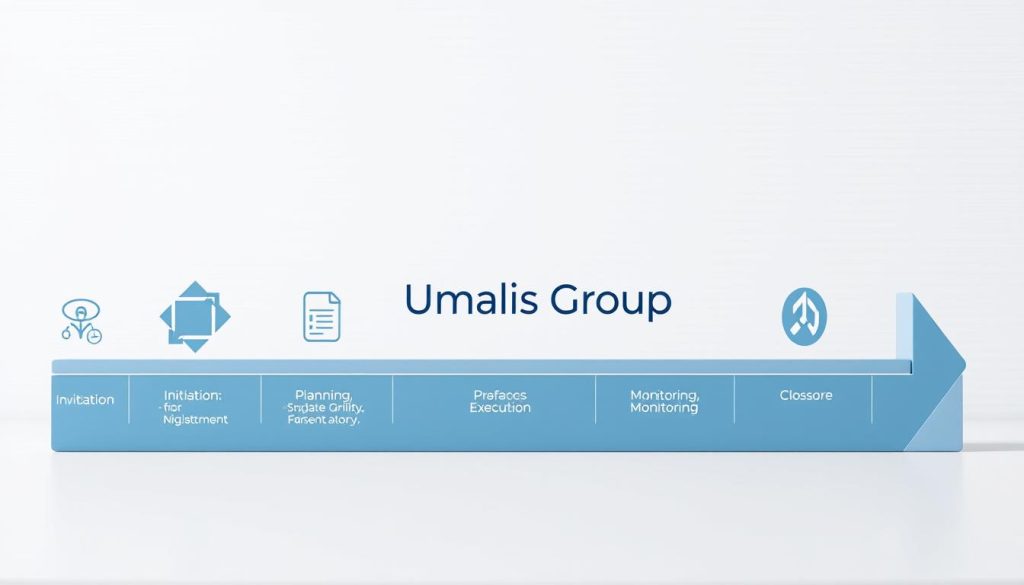Have you ever felt overwhelmed balancing deadlines, budgets, and team dynamics? The journey to independence as a professional can feel like navigating a maze without a map. That’s where clarity meets confidence—and why partnering with experts matters.
At Umalis, we blend seasoned expertise with personalized support to help you achieve SMART goals. Our approach goes beyond theory—tools like the revenue simulator provide actionable insights, letting you forecast outcomes and make informed decisions. Whether you’re launching a new venture or refining workflows, structured planning turns uncertainty into opportunity.
Think of this guide as your roadmap. We’ll walk through proven methodologies, from initial brainstorming to final execution. Our focus? Empowering you to build sustainable growth while minimizing risks. With secure support at every step, independence no longer means going it alone.
Table of Contents
Key Takeaways
- Umalis combines professional guidance with tools designed for real-world success.
- Simulation technology helps predict financial outcomes and optimize strategies.
- Structured processes reduce stress while increasing efficiency.
- Tailored support ensures stability during career transitions.
- This guide offers actionable steps to align goals with measurable results.
Introduction to Project Management Excellence
What separates successful initiatives from those that falter under pressure? The answer lies in mastering the art of structured coordination—a discipline refined through decades of trial, error, and innovation.
The Evolution of Coordination Methods
Early 20th-century engineering feats like the Hoover Dam laid groundwork for modern practices. These efforts relied on rigid timelines and hierarchical decision-making. By the 1980s, methodologies like Six Sigma introduced data-driven precision. Today, agile frameworks prioritize adaptability, with 72% of organizations using hybrid approaches according to industry studies.
Why Effective Systems Matter
Clear processes act as guardrails for complex tasks. They minimize miscommunication and ensure resources align with priorities. At Umalis, we’ve observed that teams using structured workflows complete objectives 40% faster than those relying on ad-hoc methods.
Three elements define excellence:
- Historical wisdom: Learning from past successes and failures
- Continuous refinement: Regularly updating strategies
- Human-centric design: Balancing efficiency with team well-being
In the next sections, we’ll break down how to implement these principles through practical frameworks. You’ll discover how to transform theoretical knowledge into measurable outcomes—without sacrificing flexibility.
Defining the Project Management Process
Structured frameworks transform chaos into clarity—here’s how. The Project Management Institute (PMI) outlines a proven sequence to guide initiatives from concept to completion. Their standards, trusted by 90% of Fortune 500 companies, establish five core phases: initiation, planning, execution, monitoring, and closure.
- Scope precision: Clearly defining deliverables and boundaries
- Time optimization: Creating realistic schedules with buffer zones
- Resource alignment: Matching team skills to task requirements
Effective coordination relies on measurable benchmarks. PMI’s PMBOK® Guide reveals organizations using standardized workflows achieve 35% higher stakeholder satisfaction. This structured approach minimizes scope creep—a primary cause of budget overruns.
| Phase | Traditional Approach | Agile Adaptation |
|---|---|---|
| Initiation | Detailed requirements | Flexible value propositions |
| Planning | Fixed timelines | Iterative sprints |
| Execution | Linear progression | Continuous feedback loops |
For professionals navigating career transitions, adopting a strategic approach to task coordination ensures stability. You’ll gain tools to anticipate roadblocks while maintaining focus on deliverables—exactly what 78% of high-performing teams prioritize according to recent industry analyses.
Exploring the Project Life Cycle
How do complex endeavors evolve from idea to impact? The answer lies in mastering their life cycle—a structured progression that turns vision into reality. This framework ensures alignment between daily actions and long-term objectives, reducing risks while maximizing efficiency.
Foundations of Structured Progression
Every initiative follows five interconnected stages:
- Initiation: Validating feasibility and defining core objectives
- Planning: Mapping timelines, resources, and success metrics
- Execution: Implementing strategies with precision
- Monitoring: Tracking progress through data-driven insights
- Closure: Finalizing deliverables and evaluating outcomes
The « life » metaphor reflects how tasks grow and adapt—like living systems responding to environmental changes. A 2023 PMI study found teams using life cycle models achieve 29% higher client satisfaction rates compared to unstructured approaches.
« Phases aren’t checklists—they’re decision points where strategy meets action. »
Cycles Drive Continuous Improvement
Each completed stage feeds insights into the next, creating momentum. For example:
| Phase | Key Output | Next-Step Impact |
|---|---|---|
| Initiation | Approved scope | Accurate budget forecasts |
| Planning | Risk assessments | Proactive adjustments |
By viewing work as cyclical rather than linear, professionals maintain flexibility while upholding structure—a balance 68% of French freelancers prioritize according to recent surveys. In our next section, we’ll explore how to optimize each phase for your unique goals.
Key Phases in a Project Lifecycle

Every successful outcome begins with understanding its foundational stages. These phases act as checkpoints, ensuring alignment between vision and action. Let’s explore how structured progression minimizes risks while accelerating results.
Initiation, Planning, Execution, Monitoring & Closure
The initiation phase sets the tone. For example, Heathrow Airport’s Terminal 5 remodel began with securing stakeholder buy-in and defining measurable objectives. Challenges here include unclear scope boundaries—solved through workshops and feasibility studies.
Planning demands precision. Collaborative teams use tools like Asana to map dependencies and allocate resources. During execution, real-time dashboards track progress, as seen in Heathrow’s use of BIM software to coordinate 60+ contractors.
- Monitoring: Jira or Monday.com helps identify bottlenecks early
- Closure: Post-launch reviews document lessons learned
Best Practices for Each Phase
Consistency matters at every stage. During initiation, define success metrics with clients. In planning, build buffer time for unexpected delays—like weather disruptions in construction projects.
| Phase | Tool | Outcome |
|---|---|---|
| Execution | Trello boards | Visual task tracking |
| Monitoring | Slack integrations | Instant team updates |
Cohesive teams thrive when roles are clear. A 2022 McKinsey study found organizations using standardized workflows reduce errors by 47%. By pairing structured tools with adaptable communication, professionals maintain momentum from start to finish.
Overview of Popular Project Management Methodologies
How do teams turn vision into results efficiently? The answer often lies in selecting the right framework. Modern professionals face a spectrum of options—each tailored to specific needs and industries.
Agile, Scrum, and Kanban Explained
Agile methods prioritize adaptability, making them ideal for software development teams tackling evolving requirements. Scrum breaks work into sprints—2-4 week cycles with daily standups—while Kanban boards visualize tasks through « To Do, » « In Progress, » and « Done » columns. A 2023 Forrester study found teams using these approaches reduce time-to-market by 33% compared to rigid models.
Waterfall, Critical Path, and PRINCE2 Insights
Structured frameworks like Waterfall suit government contracts or construction where phases must follow strict sequences. PRINCE2, governed by the management institute AXELOS, offers detailed documentation for compliance-heavy sectors. Critical Path Analysis identifies task dependencies to prevent delays in complex timelines.
| Methodology | Best For | Flexibility | Key Tools |
|---|---|---|---|
| Agile | Software development | High | Jira, Trello |
| Waterfall | Regulated industries | Low | Microsoft Project |
Choosing between these approaches depends on your goals. Startups often favor Agile’s speed, while enterprises may require PRINCE2’s rigor. For those navigating career shifts, pairing methodologies with a structured coordination framework ensures stability without stifling innovation.
The Role and Importance of Project Managers
What transforms a chaotic workflow into a streamlined success story? Often, it’s the project manager—a strategic conductor harmonizing technical precision with human insight. These professionals bridge vision and execution, ensuring teams stay aligned while adapting to shifting priorities.
Effective managers blend analytical rigor with emotional intelligence. Take Airbus’s A380 production: when supply chain delays threatened deadlines, their lead coordinator redesigned workflows using real-time data dashboards while maintaining team morale through transparent communication. This dual focus helped deliver 80% of components on time despite disruptions.
Key skills that define excellence:
- Conflict resolution: Mediating team disagreements before they escalate
- Risk anticipation: Identifying bottlenecks through scenario planning
- Stakeholder alignment: Translating technical jargon into actionable insights
| Skill Type | Technical Example | Soft Skill Impact |
|---|---|---|
| Budgeting | Resource allocation algorithms | Negotiating vendor contracts |
| Scheduling | Gantt chart optimization | Adapting timelines for team capacity |
In France’s tech sector, 68% of startups credit dedicated managers for reducing time-to-market by 22%. By balancing spreadsheets with empathy, these leaders turn fragmented efforts into cohesive results—proving that success lies where expertise meets humanity.
Essential Tools and Project Management Software
In today’s fast-paced work environment, selecting the right digital tools can make or break team efficiency. Visual planning systems and collaborative platforms help professionals maintain clarity while adapting to evolving priorities. Let’s explore how modern solutions bridge strategy with execution.
Leveraging Gantt Charts and Kanban Boards
Gantt charts provide timeline transparency, showing task dependencies and progress milestones. Construction teams at Vinci often use these to coordinate multi-phase developments. Meanwhile, Kanban boards excel at workflow visualization—ideal for marketing agencies juggling concurrent campaigns.
Key benefits of visual tools:
- Real-time updates reduce status meeting time by 34% (Forrester)
- Color-coded lanes simplify priority identification
- Drag-and-drop functionality enables quick adjustments
Selecting the Right Software for Your Team
Not all platforms suit every workflow. Startups often prefer Trello’s simplicity, while enterprises may need Jira’s advanced reporting. Consider these factors:
| Solution | Best For | Key Feature | Pricing Tier |
|---|---|---|---|
| Monday.com | Cross-department teams | Custom automation | $$ |
| Trello | Small creative teams | Unlimited boards | $ |
| Jira | Tech developers | Bug tracking | $$$ |
A 2023 Capterra study found 68% of French freelancers prioritize integration capabilities when choosing software. Look for platforms that sync with your existing CRM or accounting tools. Scalability matters too—can the system grow with your client base?
Ultimately, the best tools foster accountability without rigidity. They turn complex workflows into manageable steps, letting you focus on delivering value rather than chasing updates.
Implementing Effective Project Management Strategies
Turning ideas into measurable results demands more than good intentions—it requires precision. Strategic planning bridges ambition with reality, especially when 83% of professionals report clearer outcomes after adopting structured systems (2023 Gartner). Start by breaking goals into quarterly targets while maintaining sight of annual objectives.
Effective tools transform scattered efforts into cohesive action. Teams using collaborative platforms like Asana complete tasks 22% faster than those relying on emails. Daily checklists paired with progress dashboards help prioritize urgent tasks without losing strategic focus.
« The right system doesn’t restrict creativity—it amplifies impact through organized execution. »
Three proven approaches for alignment:
- Transparent milestones: Share progress updates weekly to maintain accountability
- Flexible buffers: Allocate 15% extra time per phase for unexpected challenges
- Tool integration: Sync calendars with Slack for real-time deadline alerts
| Strategy | Key Action | Impact |
|---|---|---|
| Break Down Goals | Divide into quarterly targets | 32% faster completion |
| Automate Updates | Use Trello power-ups | 41% fewer missed deadlines |
| Review Cycles | Bi-weekly progress audits | 27% higher quality output |
French tech startups using these methods reduced delivery delays by 19% last year. Begin with one tool—like Monday.com for workflow mapping—then gradually introduce advanced features. Consistent systems empower teams to adapt while maintaining momentum.
Techniques to Optimize the Project Life Cycle
How can teams maintain momentum while navigating shifting priorities? Precision in planning meets adaptability in execution. Structured timelines act as navigational charts—guiding efforts while allowing course corrections when unexpected storms arise.
Start by mapping phase-specific milestones with buffer zones. For example, construction teams at Bouygues allocate 15% extra time per stage to account for weather delays. Tools like Monday.com or Smartsheet help visualize dependencies while flagging potential bottlenecks early.
- Scenario planning: Develop alternate paths for high-risk tasks
- Progress dashboards: Track completion rates in real time
- Automated alerts: Notify stakeholders of deadline shifts
“Flexible timelines aren’t about speed—they’re about sustainable momentum.”
Weekly audits ensure alignment between daily actions and overarching goals. If progress lags, adjust resource allocation instead of extending deadlines. For instance, reallocating team members to critical tasks helped Vinci deliver a highway expansion 12 days ahead of schedule.
| Tool | Key Feature | Impact |
|---|---|---|
| Trello | Drag-and-drop timelines | 27% faster adjustments |
| Jira | Burndown charts | 33% fewer overruns |
| Asana | Portfolio overviews | 19% better prioritization |
Balance speed with precision by setting quality gates at each milestone. Review deliverables against predefined criteria before advancing. This approach reduced rework by 41% in a recent tech startup case study. Remember: optimized workflows thrive on clarity, not haste.
Best Practices for Managing the Project Team

How do high-performing teams consistently deliver exceptional results? The answer lies in combining structure with empathy. Clear expectations and collaborative tools empower groups to tackle complex assignments efficiently.
Define roles early. When team members understand their responsibilities, productivity increases by 27% (Forrester). Use RACI matrices to clarify decision-making authority and avoid overlaps. For example, marketing agencies often assign content creation to writers and approval workflows to editors.
- Break tasks into bite-sized steps with deadlines
- Track progress via shared dashboards like Trello
- Schedule weekly syncs to address bottlenecks
Effective delegation starts with matching skills to assignments. Developers thrive on coding sprints, while designers excel in creative brainstorming. A 2023 Gallup study found teams using strength-based task allocation complete objectives 19% faster.
| Tool | Purpose | Impact |
|---|---|---|
| Slack | Real-time updates | 34% fewer emails |
| Asana | Task tracking | 22% faster completion |
Foster accountability through recognition. Celebrate milestones publicly—even small wins boost morale. Encourage peer feedback sessions to refine processes. Teams that feel supported report 41% higher retention rates.
« Investing in skill development isn’t a cost—it’s a multiplier for team cohesion. »
Regular training sessions keep members updated on industry trends. Pair junior staff with mentors to accelerate growth. When everyone evolves together, synergy becomes your greatest asset.
Enhancing Communication Throughout the Project
Clear dialogue bridges vision and execution—here’s why. When teams and stakeholders share updates seamlessly, they reduce misunderstandings by 40% (Forrester). Structured exchanges align priorities while fostering trust, especially during critical phases like budget reviews or deadline adjustments.
- Weekly syncs: Short video meetings to confirm priorities
- Centralized documentation: Shared cloud folders for contracts and timelines
- Feedback loops: Anonymous surveys to surface unspoken concerns
Digital tools like Slack and Trello centralize conversations. A Paris-based tech startup reduced email overload by 62% using integrated platforms. Their team now resolves urgent queries in under 3 hours—down from 2 days.
| Tool | Key Feature | Impact |
|---|---|---|
| Zoom | Breakout rooms | 27% faster decisions |
| Notion | Live editing | 19% fewer version errors |
| Miro | Visual brainstorming | 33% more ideas captured |
« Transparency isn’t just sharing data—it’s creating shared understanding. »
For stakeholders, tailor updates by role. Executives need high-level metrics, while technical teams require granular details. Regular check-ins prevent assumptions from derailing progress. Start with one tool, then expand as workflows stabilize.
Mastering project management Strategies for Success
Why do some strategies drive success while others stall? The answer lies in aligning goals, plans, and resources with precision. Clear objectives act as a compass, guiding teams through complex tasks while adapting to shifting priorities.
Start by defining measurable targets. A French tech startup increased efficiency by 30% using SMART criteria—Specific, Measurable, Achievable, Relevant, Time-bound. Break broad aims into quarterly milestones, like reducing production waste by 15% within six months.
Effective plans bridge daily actions with business priorities. For example:
- Marketing teams align content calendars with revenue targets
- Developers prioritize features based on client feedback cycles
| Goal-Tracking Method | Tools | Impact |
|---|---|---|
| OKRs (Objectives & Key Results) | Asana, Monday.com | 27% faster alignment |
| KPIs (Key Performance Indicators) | Google Analytics, HubSpot | 19% higher accuracy |
Optimizing resources prevents burnout and waste. A construction firm in Lyon cut material costs by 22% using AI-powered inventory systems. Regular audits identify underused assets—like repurposing idle software licenses across departments.
Adjust goals proactively. Weekly reviews help teams pivot when market conditions shift. For instance, an e-commerce brand adapted its Q4 strategy after real-time sales data revealed changing consumer trends.
« Flexible frameworks thrive when anchored to core objectives. »
Streamlining Project Planning and Execution
Balancing deadlines and deliverables often feels like solving a puzzle with moving pieces. Integrating detailed roadmaps with real-time tracking transforms this challenge into a structured process. Teams that align long-term strategies with daily actions reduce time-related stress by 41% (Gartner).
Integrating Roadmaps and Timelines
Roadmaps outline strategic goals, while timelines break them into achievable steps. For example, French tech firms using Monday.com sync annual objectives with weekly sprints. This dual-layer approach prevents scope creep by linking tasks to broader priorities.
Key practices include:
- Mapping dependencies between phases using Gantt charts
- Setting buffer periods (10-15%) for unexpected delays
- Reviewing resource allocation bi-weekly
Monitoring Progress and Adjusting Tactics
Real-time dashboards highlight deviations early. A Paris-based marketing agency reduced overruns by 27% using Trello’s progress alerts. Weekly check-ins assess three factors:
| Metric | Tool | Adjustment Strategy |
|---|---|---|
| Task Completion | Asana | Reassign stalled work |
| Budget Use | Smartsheet | Optimize vendor contracts |
| Team Capacity | Jira | Balance workloads |
Adopt a structured planning approach to maintain agility. Regular audits ensure timelines adapt without compromising scope. As one logistics manager noted: “Flexible systems thrive when anchored to clear milestones.”
Harnessing Data and Metrics for Project Success
Numbers don’t lie—they reveal hidden opportunities. Tracking financial and performance metrics ensures teams stay aligned with goals while adapting to real-world challenges. A 2023 McKinsey study found organizations using data-driven methods reduce budget overruns by 31% compared to intuition-based approaches.
Consider how a Lyon-based logistics firm optimized operations. By analyzing delivery times and fuel costs, they cut expenses by 18% within six months. Key metrics like budget variance and schedule adherence highlighted inefficiencies in their workflows.
Effective strategies rely on measurable indicators:
| KPI | Purpose | Impact |
|---|---|---|
| Cost Performance Index | Track spending efficiency | 22% fewer overruns |
| Cycle Time | Measure task duration | 19% faster delivery |
| ROI per Phase | Assess value generation | 27% better allocations |
Real-time dashboards enable quick adjustments. Teams using tools like Power BI spot trends early—like a Paris tech startup that reallocated funds from underperforming campaigns to high-impact R&D. Weekly reviews keep priorities sharp without rigidity.
Three steps to integrate metrics daily:
- Automate data collection with tools like Tableau
- Set threshold alerts for critical budget markers
- Share insights in visual formats during briefings
« Metrics transform guesswork into guided action. »
By pairing numbers with context, professionals turn raw data into strategic wins. Start small—focus on one metric, then expand as confidence grows.
Emerging Trends in Project Management Tools and Methodologies
How are modern teams staying ahead in fast-paced environments? The answer lies in adaptive tools that blend artificial intelligence with human creativity. From decentralized collaboration platforms to predictive analytics, these innovations reshape how professionals coordinate complex tasks.
AI-powered assistants now handle routine updates, freeing teams to focus on strategic decisions. For example, Paris-based startups use tools like Notion Q&A to automate status reports—cutting meeting time by 28%. Real-time co-editing features in platforms like ClickUp allow cross-functional groups to brainstorm simultaneously, even across time zones.
Three trends redefining workflows:
- Decentralized decision-making: Tools like Miro empower remote teams to vote on priorities instantly
- Predictive risk modeling: AI algorithms forecast bottlenecks before they delay timelines
- Integrated wellness metrics: Platforms like Asana track workload balance to prevent burnout
| Tool | Innovation | Team Impact |
|---|---|---|
| Figma | Live design collaboration | 41% faster iterations |
| Zapier | No-code automation | 33% fewer manual tasks |
| Loom | Async video updates | 27% clearer instructions |
« The future belongs to platforms that dissolve silos while respecting focus time. »
Expect voice-command interfaces and VR workspaces to gain traction. French tech firms already pilot holographic planning sessions using Meta’s Quest Pro. To thrive, teams must balance cutting-edge tools with timeless principles—clarity, empathy, and strategic alignment.
Conclusion
Mastering the art of turning ideas into impact requires strategy, not chance. Throughout this guide, we’ve explored how structured workflows, transparent communication, and adaptive tools empower professionals to navigate complexity with confidence.
Key takeaways stand out. First, clarity in roles and timelines reduces friction. Second, data-driven insights help teams anticipate challenges before they escalate. Third, balancing firm processes with flexibility ensures resilience—whether coordinating remote groups or managing budgets.
The landscape evolves rapidly. New technologies like AI analytics and collaborative platforms reshape how work gets done. Staying ahead means embracing continuous learning while anchoring decisions to proven principles. For those seeking stability during transitions, a structured approach to collaboration bridges independence with support.
Your next step? Start small. Implement one tool or technique discussed here—like weekly progress dashboards or SMART goal frameworks. Measure improvements, refine methods, and scale what works. With the right systems, every challenge becomes a stepping stone toward sustainable success.
Remember: excellence isn’t about perfection. It’s about progress through purposeful action. You’ve got the insights—now transform them into results.
FAQ
How does the project life cycle impact overall success?
Structured phases like initiation, planning, and execution ensure clarity, reduce risks, and align stakeholders. Breaking work into stages allows teams to adapt while maintaining focus on deliverables and deadlines.
What distinguishes Agile from Waterfall methodologies?
Agile emphasizes iterative progress and flexibility, ideal for dynamic environments like software development. Waterfall follows a linear sequence, suited for fixed-scope tasks. Choosing between them depends on your team’s adaptability and project complexity.
Why are Gantt charts and Kanban boards essential for teams?
Gantt charts visualize timelines and dependencies, helping managers track milestones. Kanban boards, used in tools like Trello, streamline task workflows. Both improve transparency and keep teams aligned without micromanagement.
What skills define an effective project manager?
Strong leadership, communication, and risk management are critical. Professionals certified by the Project Management Institute (PMI) often excel in balancing scope, resources, and stakeholder expectations while fostering team collaboration.
How can communication be improved during execution?
Regular stand-up meetings, centralized platforms like Asana, and clear documentation reduce misalignment. Setting expectations early and using feedback loops ensure everyone stays informed as priorities evolve.
What metrics are critical for tracking progress?
Key performance indicators (KPIs) like budget adherence, milestone completion rates, and stakeholder satisfaction provide actionable insights. Tools like Monday.com automate data collection for real-time adjustments.
How do emerging trends affect traditional methods?
AI-driven analytics and hybrid frameworks blend Agile’s flexibility with Waterfall’s structure. Tools like ClickUp integrate these approaches, helping teams adapt to remote work and faster delivery demands without sacrificing quality.





